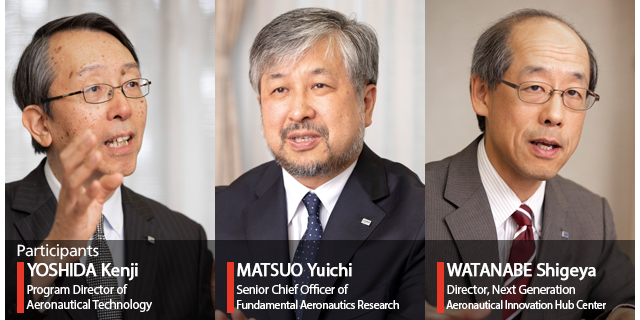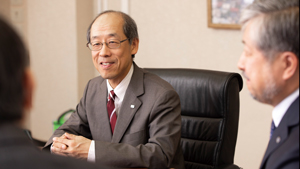About us
JAXA Aviation helps to create a safer and more prosperous society with aeronautics-related research and development activities.
FLIGHT PATH No.21 | 2018 SUMMER
<JAXA's Goals in the Fourth Mid-to-long-term Plan>
Discussion by Three Key Persons Thinking Ahead of the Times and Producing Excellent Researchers to Become the World's Top Research Institution

Research and Development of the Aviation Technology Directorate
JAXA Aviation Technology Directorate (JAXA Aeronautics) conducts research and development that contribute to the following three goals.
- Enhancing international competitiveness of Japan's aviation industry
- Increasing the safety of air transportation and fostering secure society with aircraft
- Contributing to breakthroughs in the air transportation of tomorrow
Building on the successes of the Third Mid-term Plan, in the Fourth Mid-to-long-term Plan we will further pursue R&D programs along the three themes of the environment, safety, and air transportation of tomorrow, and undertake basic and fundamental researches that underpin these efforts. Meanwhile, the Innovation Hub will work to deliver high-impact results to ensure maximum benefit to society by enhancing collaboration with diverse players to achieve shared visions.
Venturing into new fields
The Fourth Mid-to-long-term Plan has started, picking up where the Third Mid-term Plan left off. What are the goals of the latest plan?
YOSHIDA: The programs that I oversee are responsible for developing technologies that can benefit the Japanese aviation industry. Currently, our main focus is on engine technology and supersonic transport technology. As for engine technology, we researched and developed the low-pressure system of engines in the aFJR project in the Third Mid-term Plan. In the Fourth Mid-to-long-term Plan, we will tackle the core engine, that is, the high-pressure system of engines, and produce results that will assist the strategies of the aviation industry. As for supersonic aircraft technology, we have accumulated a significant amount of knowledge through the D-SEND project and other efforts. But numerous technological challenges still remain to be solved. In the coming years, JAXA will carry out further R&D in those areas.
How about the Next Generation Aeronautical Innovation Hub Center?
WATANABE: The Next Generation Aeronautical Innovation Hub Center will aim to leverage aeronautical technology for the benefit of society. One of the keywords that define our activities is “safety,” and this includes not just technology for making aircraft themselves safer but also the use of aeronautical technology to make the world a safer place. Specifically, this involves work that is connected directly with the safety of the public, like using aircraft to rescue victims and deliver supplies in times of disaster. Having worked for the Aeronautical Innovation Hub Center for three years, I learned that connections with people in different fields and different types of industries are extremely important. We should of course work with our peers in the aviation field, but we should also actively seek opportunities to develop new relationships with people in different fields. This, I believe, will be particularly important when we try to meet many of the challenges that we have been unable to solve so far.
How about fundamental research?
MATSUO: One of the main roles of fundamental research is the research and development of enabling technologies, such as analysis, evaluation, and testing technologies. We also develop, maintain, and operate equipment and facilities like wind tunnels and research aircraft used for testing. Another key role of fundamental research is cultivating core technologies and essential technologies for the future. In the Third Mid-term Plan, we went after practical outcomes and obtained results that came very close to social implementation, such as computational fluid dynamics (CFD) software called FaSTAR and measurement technology using pressure-sensitive paint (PSP). On the other hand, research designed to grow promising technologies (“exploratory research”) is also important. That's what we intend to focus on in the Fourth Mid-to-long-term Plan.
You're talking about developing JAXA's future core technologies, correct?
MATSUO: Yes. It's a tough challenge, but that's the area we'd like to mainly tackle. JAXA has a number of research schemes, one of which is a competitive exploratory research scheme. We have been using this system since 2017 to encourage researchers to take up new challenges. Even a failure can lead to positive results, so I hope researchers won't be afraid to explore bold ideas.
WATANABE: We recently initiated a new scheme to find new research frontiers. Since society keeps changing, over time you may stray away from the needs of society if you only pursue your area of specialty. So we encourage our researchers to look at different fields as well. This activity is designed to encourage researchers to explore new fields, even if they have to slow down what they have been working on. We are hoping that this will lead to the creation of new research areas, or growth of promising technologies, to meet changes in the outside world.
Specifically, what kind of technologies do you have in mind as new fields?

WATANABE: One approach would be to combine various fields of technology. By mixing different technologies like sensors and artificial intelligence (AI), you might be able to create something truly innovative. If you bring a new tool like unmanned aerial vehicles to a research that seeks to find ways to make the world safer by using conventional manned aircraft, what was previously thought impossible might become possible. In that sense, to generate a huge impact in society, I think it would be effective to work on R&D with people who have technologies, knowledge, and experience that we don't have.
Is there any plan to tackle new fields in fundamental research?
MATSUO: One of the strengths of fundamental research is numerical simulation technology. This mainly involves CFD, but we are currently working on measures to combine the technologies of three departments―the Numerical Simulation Research Unit, Aerodynamics Research Unit, and Flight Research Unit, which researches technologies required for actually flying an airplane―to research and develop integrated simulation technologies. Another strength is structure and materials, in particular composite material technology. This encompasses technologies for creating, evaluating, and testing new composite materials. So these are the strengths of fundamental research that form its two pillars. I'm actually planning to create a third pillar, which will probably be propulsion, or engine demonstration technology.
That propulsion research eventually leads to the development of engine technology in aviation programs.
YOSHIDA: Exactly. Actually, we are currently working to launch new projects using technologies cultivated by fundamental research. The goal of our programs is social implementation, but for that to happen, the technologies need to be refined to a very high level. We always keep our eyes on promising technologies developed through fundamental research and exploratory research, or through efforts by the Aeronautical Innovation Hub Center.
September 19, 2018